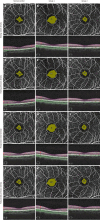Retinal microcirculation changes in prediabetic patients with short-term increased blood glucose using optical coherence tomography angiography
- PMID: 39355394
- PMCID: PMC11440280
- DOI: 10.4329/wjr.v16.i9.407
Retinal microcirculation changes in prediabetic patients with short-term increased blood glucose using optical coherence tomography angiography
Abstract
Background: Retinal microcirculation alterations are early indicators of diabetic microvascular complications. Optical coherence tomography angiography (OCTA) is a noninvasive method to assess these changes. This study analyzes changes in retinal microcirculation in prediabetic patients during short-term increases in blood glucose using OCTA.
Aim: To investigate the changes in retinal microcirculation in prediabetic patients experiencing short-term increases in blood glucose levels using OCTA.
Methods: Fifty volunteers were divided into three groups: Group 1 [impaired fasting glucose (IFG) or impaired glucose tolerance (IGT)], Group 2 (both IFG and IGT), and a control group. Retinal microcirculation parameters, including vessel density (VD), perfusion density (PD), and foveal avascular zone (FAZ) metrics, were measured using OCTA. Correlations between these parameters and blood glucose levels were analyzed in both the fasting and postprandial states.
Results: One hour after glucose intake, the central VD (P = 0.023), central PD (P = 0.026), and parafoveal PD (P < 0.001) were significantly greater in the control group than in the fasting group. In Group 1, parafoveal PD (P < 0.001) and FAZ circularity (P = 0.023) also increased one hour after glucose intake. However, no significant changes were observed in the retinal microcirculation parameters of Group 2 before or after glucose intake (P > 0.05). Compared with the control group, Group 1 had a larger FAZ area (P = 0.032) and perimeter (P = 0.018), whereas Group 2 had no significant differences in retinal microcirculation parameters compared with the control group (P > 0.05). Compared with Group 1, Group 2 had greater central VD (P = 0.013) and PD (P = 0.008) and a smaller FAZ area (P = 0.012) and perimeter (P = 0.010). One hour after glucose intake, Group 1 had a larger FAZ area (P = 0.044) and perimeter (P = 0.038) than did the control group, whereas Group 2 showed no significant differences in retinal microcirculation parameters compared with the control group (P > 0.05). Group 2 had greater central VD (P = 0.042) and PD (P = 0.022) and a smaller FAZ area (P = 0.015) and perimeter (P = 0.016) than Group 1. At fasting, central PD was significantly positively correlated with blood glucose levels (P = 0.044), whereas no significant correlations were found between blood glucose levels and OCTA parameters one hour after glucose intake.
Conclusion: A short-term increase in blood glucose has a more pronounced effect on retinal microcirculation in prediabetic patients with either IFG or IGT.
Keywords: Blood glucose; Central vessel density; Impaired fasting glucose; Impaired glucose tolerance; Optical coherence tomography angiography; Prediabetes; Retinal microcirculation.
©The Author(s) 2024. Published by Baishideng Publishing Group Inc. All rights reserved.
Conflict of interest statement
Conflict-of-interest statement: The authors declare that they have no known competing financial interests or personal relationships that could have appeared to influence the work reported in this paper.
Figures

References
-
- American Diabetes Association. 2. Classification and Diagnosis of Diabetes: Standards of Medical Care in Diabetes-2020. Diabetes Care. 2020;43:S14–S31. - PubMed
-
- Saeedi P, Petersohn I, Salpea P, Malanda B, Karuranga S, Unwin N, Colagiuri S, Guariguata L, Motala AA, Ogurtsova K, Shaw JE, Bright D, Williams R IDF Diabetes Atlas Committee. Global and regional diabetes prevalence estimates for 2019 and projections for 2030 and 2045: Results from the International Diabetes Federation Diabetes Atlas, 9(th) edition. Diabetes Res Clin Pract. 2019;157:107843. - PubMed
-
- Wolter JR. Diabetic retinopathy. Am J Ophthalmol. 1961;51:1123–1141. - PubMed
LinkOut - more resources
Full Text Sources

